Crushing plant in Chile represents a high-potential investment in a market driven by mining expansion and infrastructure growth. With government projects accelerating road, port, and urban development, and mining operations demanding robust processing capabilities, the need for high-capacity, flexible, and energy-efficient crushing solutions has never been greater. Success in this market requires equipment designed for Chile’s diverse geography and regulatory environment.
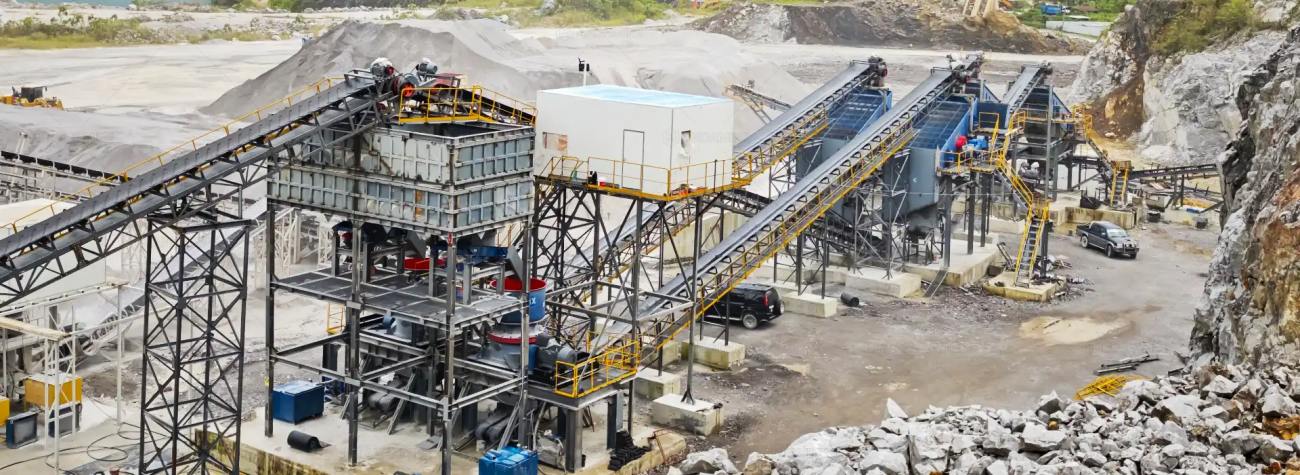
Chile’s Crushing Plant Market: Demands and Opportunities

Mining-Driven Demand: Processing Hard Ores
Chile produces nearly 30% of the world’s copper, alongside lithium, gold, and other industrial minerals. This drives demand for high-capacity, heavy-duty crushing plants capable of handling millions of tons of hard, abrasive ore annually.
- High-Capacity Requirements: Large mining operations, such as Escondida and Chuquicamata, require multi-stage crushing circuits, including jaw, cone, and impact crushers, to reduce ROM (run-of-mine) material for downstream grinding and beneficiation.
- Material-Specific Solutions: Lithium extraction in the Salar de Atacama demands mobile, corrosion-resistant crushers suitable for saline and abrasive environments.
- Efficiency and Reliability: Selecting robust, wear-resistant equipment ensures continuous operation, lowers maintenance costs, and maximizes recovery rates.
Construction-Driven Demand: Supporting Infrastructure
Chile’s urbanization and government-backed infrastructure projects—roads, ports, airports, and urban development—drive demand for high-quality crushed aggregates.
- Aggregate Quality: Seismic-prone regions like Santiago require well-shaped, contaminant-free aggregates with strict mechanical specifications for roads, bridges, and buildings.
- Efficiency and Mobility: Quarries are often distant from construction sites. Stationary crusher plants near quarries and mobile crushers on-site reduce transport costs and environmental impact.
- Government Projects: Initiatives such as road expansions and port upgrades increase nationwide demand for processed materials, creating investment opportunities for crushing plant operators.
High Efficiency and Consistent Output
Modern mobile crusher plants are equipped with advanced crushers (jaw, cone, impact) and smart control systems that optimize crushing cycles and ensure consistent product quality. The ability to customize output sizes and quickly adjust to varying materials improves production efficiency, reducing rework and waste.
Geographic and Environmental Challenges
Chile’s diverse terrain poses unique operational demands:
- Climate Extremes: Atacama Desert equipment should endure UV radiation, fine abrasive dust, and temperature swings. Southern regions require corrosion protection and waterproofing.
- High Altitude: Many mining operations exceed 3,000 meters, requiring engine derating, hydraulic adjustments, and specialized equipment for thin air.
- Seismic Activity: Earthquake-resistant foundations, flexible couplings, and secure anchoring are necessary to ensure plant stability.
Integrated Efficiency Considerations
- Energy Efficiency: Crushing plants increasingly adopt energy-optimized circuits, reducing power consumption while meeting environmental standards.
- Mobility: Mobile crushing solutions allow flexibility for temporary or remote sites, improving logistics and minimizing downtime.
- Sustainability: Combining energy efficiency with operational flexibility supports mining and construction needs while aligning with Chile’s environmental regulations.
Different Crushing Plant Solutions Used Across Chile
Stationary Crushing Plants for Continuous, Large-Scale Production
Stationary crushing plants are widely used in Chile’s large-scale mining and quarrying sectors, especially in regions like Antofagasta and Atacama. These plants are built for long-term production and consistent output.
Key Advantages:
- High Capacity: Capable of processing millions of tons of ore or aggregates each year, ideal for copper and iron mining operations.
- Robust Construction: Designed to withstand Chile’s harsh desert conditions and continuous heavy-duty use.
- Automation & Efficiency: Equipped with modern control systems for real-time monitoring, improving safety and reducing manpower.
- Typical Setup: Jaw crusher (primary) → cone crusher (secondary) → impact crusher or VSI (tertiary), integrated with vibrating screens and belt conveyors.
Mobile Crushing Plants: Flexible Solutions for On-Site Production
Mobile crushing plants are increasingly popular in Chile due to their flexibility and fast deployment, especially for projects in remote or mountainous regions where fixed installations are difficult.
Andamine offers the APY Series wheeled and APYL Series tracked mobile crushing plants to meet diverse project requirements, with capacities reaching 400 tph or more, delivering efficient, high-performance crushing solutions for a wide range of applications.
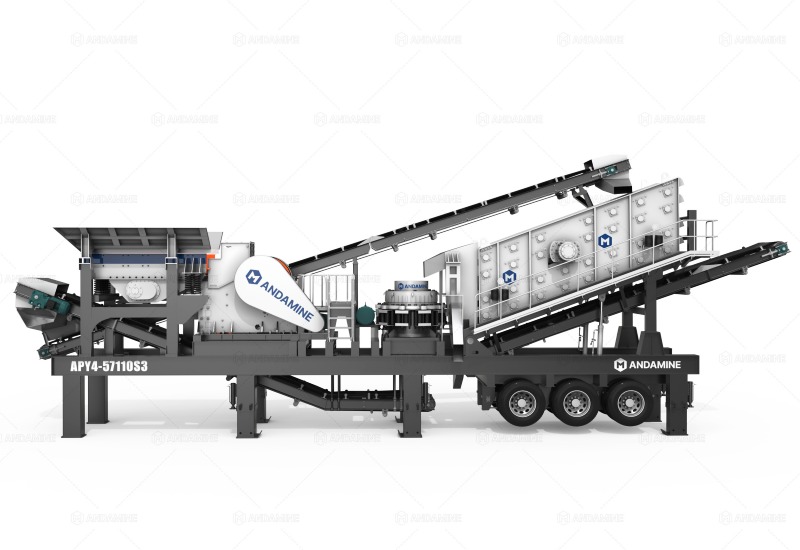
Key Advantages:
- Wheeled chassis for easy mobility: The wheeled chassis allows flexible movement between sites, reducing the need for heavy concrete foundations. Relocating the plant saves 30–60 days compared to fixed crushing stations.
- Quick-install outriggers: Hydraulic legs lift the plant synchronously, enabling rapid setup and stable deployment. This shortens installation time and reduces labor and operational costs at each site.
- Dust suppression system: Water spray effectively controls dust, improving site safety and meeting environmental requirements.

Key Advantages:
- Self-propelled tracked chassis: Can adjust position during operation, ideal for mountains, wetlands, and rough terrain.
- High-performance diesel engine: Reliable and fuel-efficient engines like Weichai or Cummins reduce downtime and energy costs.
- Advanced hydraulic system: Imported components ensure stable performance, lower maintenance, and adaptability to different conditions.
- Rigid tracked chassis design: Strong stability, high load capacity, excellent off-road and obstacle-crossing ability for challenging terrains.
Main Types of Crusher Machines
Crusher machines are essential for mining, construction, and aggregate production, efficiently breaking rocks into smaller sizes for various applications. We provide primary jaw crushers, secondary cone crushers, and impact crushers for shaping materials to meet diverse project needs.
Jaw Type Crusher Machine

Capacity: 20 – 800T/H
Feed size: ≤ 1000mm
Output size: 15–300mm
Cone Type Crusher Machine

Capacity: 18 – 1200T/H
Feed size: 20-353mm
Output size: 3-60mm
Impact Type Crushing Machine
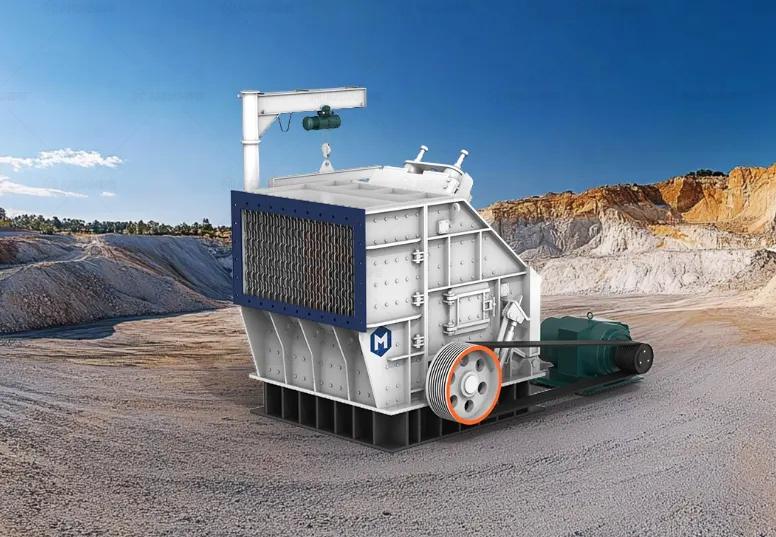
Capacity: 50 – 550T/H
Feed size: ≤900mm
Output size: 5–200mm
Now that we’ve explored the common types of stone crusher plants in Chile, you might be wondering—what real value can these machines bring to your project? Let’s take a closer look at the advantages of investing in a crushing plant in the Chilean market, so you can see if it’s the right move for you.
Advantages of Investing in a Crushing Plant in Chile
Investing in Chile offers strong potential due to resource abundance, logistics, and demand growth.
Proximity to Rich Mineral and Aggregate Resources
Chile’s extensive copper, lithium, gold, and aggregate deposits enable efficient raw material access, reducing transport costs and ensuring stable supply.
Strategic Location for Regional and Global Markets
Ports like Antofagasta, Valparaíso, and San Antonio provide export access to South America and global markets, facilitating international business expansion.
High Growth Potential in Mining and Construction
Ongoing mining expansion and infrastructure projects support steady demand for processed aggregates, making the sector attractive for investors.
Access to Global Technical Expertise
International suppliers like Andamine provide advanced crushing equipment, wear-resistant components, and maintenance support, crucial for challenging environments such as high-altitude mines or desert operations.
Investment and Economic Benefits
Investors can expect strong returns from robust local and export demand. Modern crushing plants also reduce operating costs through automation and energy-efficient systems, while integrating recycling and circular economy practices to support sustainable development.
While understanding the benefits is important, every project has unique needs. To truly get the most out of your investment, choosing the right model and configuration is key. Next, let’s discuss how to select the perfect crusher machine for your project.
How to Choose the Right Crusher Plant for Your Chilean Project


Selecting the most suitable crushing plant in Chile requires careful consideration of material characteristics, project scale, site conditions, and operational efficiency, given the country’s diverse geography and growing mining and construction sectors.
Material Type and Hardness
Chile’s mining operations primarily involve hard, abrasive ores like copper, as well as lithium, gold, and industrial minerals. Construction projects often use volcanic rock, basalt, or recycled concrete. Choosing the right crusher—jaw crusher, cone crusher, impact crusher, or combination solutions—depends on material hardness, moisture content, and required aggregate size.
For example, jaw crushers are ideal for primary crushing of hard ores such as copper or basalt, where compressive strength is high and a strong, steady crushing force is needed. Matching equipment to material ensures optimal throughput, reduces wear, and extends machine life.
Capacity and Production Requirements
For example, a large copper mine in northern Chile may use a stationary crushing plant with 500–800 TPH capacity for continuous, large-scale production. Meanwhile, a road construction project near Santiago can benefit from a mobile plant producing 80–120 TPH, offering easy relocation and flexibility across multiple sites. Accurately estimating required daily output prevents underperformance or unnecessary overinvestment.
Mobility and Site Conditions
Chile’s diverse terrain—from the high-altitude Andes to the Atacama Desert—affects plant mobility needs. Mobile crushers are ideal for temporary sites, mountainous regions, or urban construction areas with limited space, while stationary plants suit large, long-term quarry operations. Evaluating site accessibility, transport logistics, and setup complexity is critical.
Budget, Energy Efficiency, and Maintenance
Supplier Comparison
Comparing offerings from Chinese, European, and other international suppliers helps identify the best combination of cost, quality, and service, ensuring the plant meets both local regulatory standards and project-specific demands.
Selecting the right equipment is only the first step—once the plant is up and running, challenges are bound to appear. Let’s explore the common challenges and practical solutions for operating a crusher plant in Chile.
Key Challenges & Solutions for Operating a Stone Crusher Plant in Chile
Operating a stone crusher plant in Chile requires careful management of environmental compliance, worker safety, and equipment reliability. The country’s strict regulations, varied terrain, and heavy demand from mining and infrastructure projects make these aspects critical for sustainable performance.
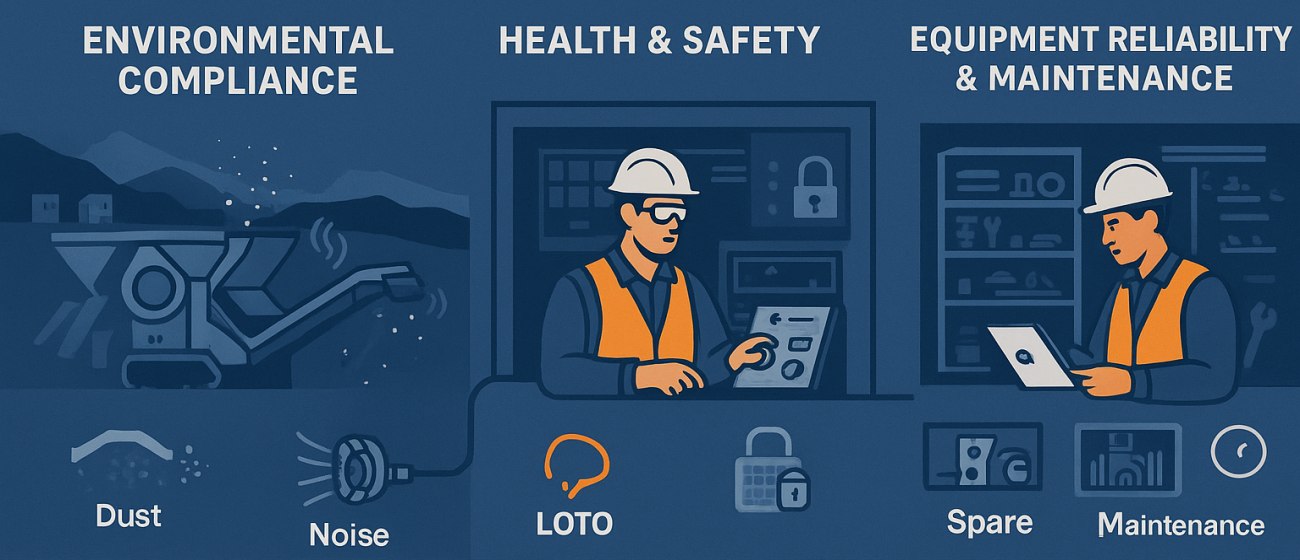
Environmental Compliance: Managing Dust and Noise Emissions
Chile enforces strict environmental laws through the Superintendence of the Environment (SMA), particularly targeting dust and noise emissions from mining and construction sites.
- Dust Control Solutions: Use water spray systems, surfactants at transfer points, enclosed conveyors, baghouse filters, mist cannons, and wheel washers to minimize airborne particles. These methods protect both workers and nearby communities.
- Noise Control Solutions: Implement acoustic enclosures around crushers and vibrating screens, and install sound-dampening panels near sensitive areas. Such measures reduce noise pollution and help maintain compliance with Chilean standards.
Health and Safety: Ensuring Worker Protection
Worker safety is a top priority in Chile’s mining and construction industries. Compliance with national safety codes and company-specific HSE (Health, Safety, and Environment) policies is essential.
Key Practices:
- Isolation and Lockout/Tagout (LOTO): Guarantees safe maintenance when working on energy sources.
- Mechanical Guarding: Shields workers from moving parts, conveyor nip points, and drive mechanisms.
- Automation and Remote Operation: Modern crushing plants allow remote monitoring from climate-controlled cabins, reducing exposure to noise, dust, and moving equipment.
Equipment Reliability and Maintenance Management
Maintaining continuous production in Chile’s demanding conditions requires a well-organized spare parts and maintenance strategy.
Best Practices:
- Inventory Planning: Keep essential wear parts—liners, bearings, belts—readily available to prevent downtime.
- Preventive Maintenance: Conduct scheduled inspections and predictive diagnostics to avoid unplanned failures.
- Skilled Workforce: Qualified operators and maintenance personnel ensure quick problem-solving and maximize uptime.
Once you’ve mastered the challenges and how to tackle them, it’s time to look ahead. Let’s take a closer look at upcoming trends and what they mean for crushing plants in the years to come.
Future Trends, Sustainability, and Outlook for Crushing Plants in Chile
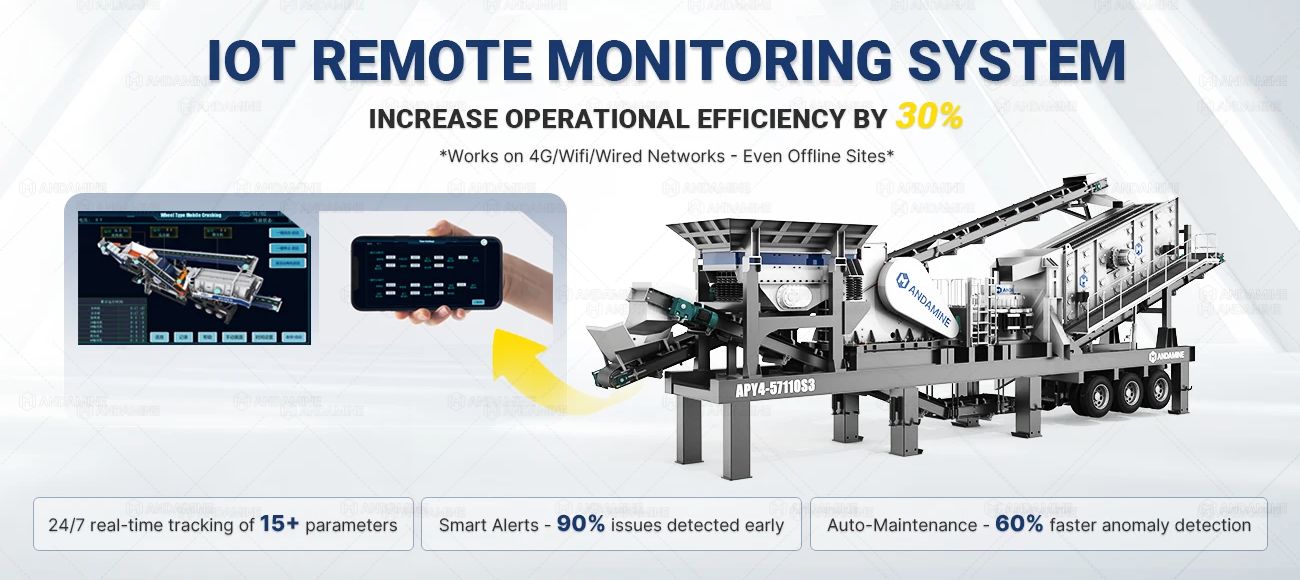
The crushing plant industry in Chile is evolving rapidly, driven by technological innovation, increasing environmental awareness, and growing demand for efficient resource management. Companies who embrace these trends are better positioned to improve safety, reduce environmental impact, and maintain competitive productivity across mining and construction projects.
Automation and Smart Technology
Digitalization is transforming Chilean crushing operations, allowing operators to maximize efficiency and minimize risks:
- Remote Monitoring: Real-time tracking of equipment performance, production output, and potential issues helps prevent unexpected downtime.
- IoT Integration: Sensors on crushers, conveyors, and screens provide predictive maintenance data, enabling timely interventions and reducing wear-related failures. Take the Andamine 4-in-1 mobile crusher as an example — it features an IoT remote monitoring system for real-time performance tracking and automatic maintenance reminders. It supports 2G/3G/4G, and when signals are weak, users can connect via Wi-Fi or wired network for stable monitoring.
- Data-Driven Optimization: Real-time analysis allows fine-tuning of crusher settings, lowering energy consumption while ensuring consistent material quality.
Electric and Hybrid Crushing Solutions
- Electric Crushers: These systems reduce greenhouse gas emissions and energy costs while maintaining high productivity levels.
- Hybrid Drives: Combining diesel and electric power allows operations in remote areas with limited electricity access while reducing fuel consumption and carbon emissions.
Adoption of electric and hybrid technologies aligns with global low-carbon initiatives and Chile’s environmental regulations, providing both ecological and economic benefits.
Circular Economy and Recycling
Chile is increasingly embracing circular economy principles in construction and mining:
- Construction Waste Recycling: Crushing plants can process concrete, asphalt, and demolition debris into reusable aggregates, reducing waste sent to landfills.
- Sustainable Material Supply: Using recycled aggregates lowers the need for virgin resources, reduces material costs, and supports environmentally responsible construction.
Integrating recycling into crushing operations not only meets environmental standards but also opens new revenue streams and strengthens corporate sustainability credentials.
Energy Efficiency and Resource Optimization
Future crushing plant operations in Chile will focus heavily on energy and resource efficiency:
- Optimized Crushing Circuits: Multi-stage crushers and conveyors designed for minimal energy loss maximize throughput while conserving power.
- Variable Frequency Drives (VFDs): These systems adjust motor speed according to material flow, lowering electricity consumption.
- Waste Heat Recovery: Some plants are implementing systems to capture and reuse energy generated during operations, further enhancing efficiency.
Future Market Outlook (2025–2030)
The outlook for Chile’s crushing plant industry is positive, driven by both infrastructure development and sustainability initiatives:
- Infrastructure Expansion: Government projects, including roads, ports, airports, and urban development, will continue to drive demand for high-quality aggregates.
- Green Transition: Increasing emphasis on eco-friendly equipment and sustainable operations will favor electric, hybrid, and recycling-capable plants.
- Investment Opportunities: Supportive policies and growing demand create opportunities for both domestic and foreign investors, including partnerships, equipment supply, and project contracting.
- Renewable Energy Integration: Investment in renewable energy and sustainable construction projects will further encourage the adoption of energy-efficient crushing solutions.
Choosing the right crushing plant is crucial for project success in Chile’s competitive construction and mining sectors. Our crushing plants combine advanced technology, mobility, and robust design to ensure consistent performance even in the toughest conditions. Whether you need a stationary or mobile solution, our team will help you select the ideal plant for your project. Invest smartly—reach out now and see how our crushers can drive your business forward.




